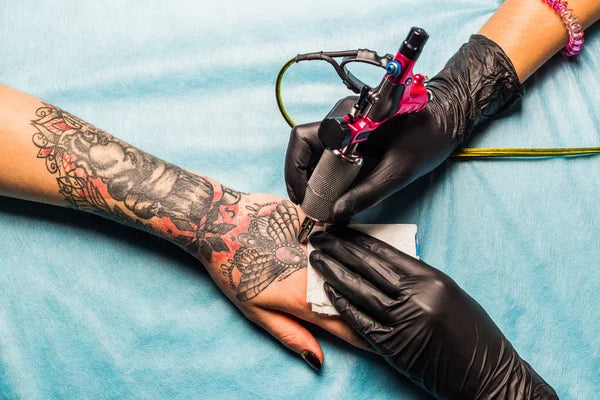Electrum's tattoo culture blog
Electrum's Tattoo Culture Blog
The Business of Tattooing - 4 tips for Dealing with Difficult Consultations
As a tattoo artist, consultations can either pave the way to amazing artwork or lead to frustrating dead ends. Difficult consultations often arise due to mismatched expectations, communication barriers, or clients unsure of what they truly want. Here's how you can expertly navigate these tricky interactions, ensuring your client leaves confident and your bookings stay full.
Read moreThe Silent Killer of Bookings: Website + Bio Mistakes
If your bookings feel slower… your BIO might be the problem. Most tattoo artists think clients choose them based on skill. Nope. Clients choose based on clarity and trust, and your bio + website are the FIRST impression that creates both. In 2024–2025, attention spans are microscopic.If your bio doesn’t explain who you are, where you are, what you do, and how to book, clients bounce instantly. Here’s the hard truth: **Most artists unintentionally sabotage their bookings with tiny online mistakes. The good news? They’re all fixable in under an hour.** Let’s break down what’s actually hurting you — and how to run a high-converting online presence like a pro. 1. The 6 Bio Mistakes That Kill Trust These are industry-wide issues, and most artists are guilty of at least 3. ❌ Mistake 1 — No location in your bio Clients leave immediately if they can’t tell where you’re based. ❌ Mistake 2 — Style is vague or missing “Tattoo Artist” tells us nothing.Say the STYLE you specialize in. ❌ Mistake 3 — No CTA (Call to Action) A bio should lead to ONE clear step:“Book here.”“Submit a request.”“Flash drops weekly.” ❌ Mistake 4 — Portfolio is cluttered Old work, inconsistent work, different styles → lowers trust. ❌ Mistake 5 — No face, no vibe People book ARTISTS, not just tattoos.A photo of you builds huge trust. ❌ Mistake 6 — Link isn’t optimized for mobile 80% of potential clients click your link from a phone.If your link tree is messy or the form takes too long, they bail. 2. Website Issues That Ruin Conversions ❌ No “start here” button People panic when they don’t know where to go. ❌ Policies are hidden (or intimidating) Clients need clarity, not fear. ❌ Booking form takes too long If it takes more than 60–90 seconds → they leave. ❌ Prices aren’t explained clearly You don’t need to list your full prices.Just explain how pricing works. ❌ No studio environment photos Clean, safe studios convert better than the best portfolios. 3. The 12-Point Portfolio Conversion Audit (This is the part that artists screenshot, save, and share.) Run this checklist TODAY: Bio Location visible in first line Specializes in 1–2 styles Call-to-action included Link goes directly to booking Instagram Top 12 posts show your best style only Pinned posts: portfolio, flash, healed work No random selfie content cluttering Website Clear “Start Here” section Policies written in friendly tone Prices explained simply Fast, mobile-optimized form Studio photos included for trust Do these twelve things, and you’ll see an immediate change in your booking quality AND volume. 4. The Psychology Behind Fixing Your Bio Clients don’t book based on logic.They book based on certainty. Your portfolio shows talent.Your bio shows professionalism. When both are aligned?You become the safest, easiest yes. 5. Copy/Paste Bio Templates Blackwork Artist Example “Blackwork tattooer in Hamilton, ON ✖Floral • occult • femme-focused piecesBooking + flash → [link]” Fine Line Artist Example “Fine line + micro realism • TorontoHealed work + availability ↓Book here: [link]” Watercolor Artist Example “Watercolor + illustrative tattoos 🎨Studio in downtown MontrealFlash drops weekly. Book at link.” These convert. Consistently. 6. Final Reminder You can be the best artist in your city…but if your bio confuses people, they’ll never make it into your chair. Your art matters.Your presentation matters just as much. Fix your digital front door.Your bookings will follow.
Clients Are Spending Differently This Year — Here’s How to Pivot
If your books feel slower, your DMs feel quieter, or clients seem hesitant to commit… you’re not imagining it. North America, the UK, and much of Europe are experiencing a tattoo recession — not because tattoos are less popular, but because consumer spending is changing. People still want tattoos.They’re just spending money differently.
The Business of Tattooing - Micro-Trends, Macro-Money: How Styles Like “Ignorant Tattoos,” “Fine-Line,” or “Sticker Sleeves” Affect Long-Term Sustainability
Micro-trends can be incredible for visibility and fast cash, but they’re not a business model by themselves. The smartest artists use trends as leverage: they attract new clients, grow social reach, and then transition those clients into bigger, more sustainable work.
The Business of Tattooing - Creating a Tattoo Studio Culture That Retains Top Talent
As a seasoned tattoo artist and studio owner, I've seen firsthand how the right culture transforms a tattoo studio from merely a workplace into a thriving creative community. Attracting skilled artists is one thing; retaining them long-term is another challenge altogether. Here's how you can build an environment that motivates your artists to stay and grow alongside your business.
The Business of Tattooing - How to price your tattoos without undervaluing your art and time
As a tattoo artist, pricing your work can be one of the most challenging aspects of the job. Setting rates that reflect your skill, experience, and time is essential—not just for your income but for establishing your value in the industry. Undervaluing your art can lead to burnout, frustration, and financial instability. Here’s how to price your tattoos confidently and fairly without selling yourself short.
The Business of Tattooing - From Passion to Profit: Business Essentials for Tattoo Artists
Turning your passion for tattooing into a thriving business involves more than just creating amazing art—it requires a solid foundation in business strategy. Whether you're just starting out or looking to streamline your existing operations, understanding the business essentials is key to sustainable growth and profitability. Here’s how to transform your tattoo artistry into a successful enterprise.
The Business of Tattooing - Why “Exposure” Isn’t Payment, But Visibility Can Be Currency
Tattoo artists have been hearing it forever: “We can’t pay you, but think of the exposure.” Most of us know that’s BS. You can’t pay rent with exposure, and you can’t buy ink with Instagram likes. But here’s the twist: in the TikTok + IG era, visibility can translate into real bookings—if you treat it strategically. The difference between empty “exposure” and valuable visibility is how you leverage it.
The Business of Tattooing - Digital Portfolios and SEO: Getting Found Online
In today’s digital-first world, having an eye-catching online portfolio isn’t just a nice-to-have—it’s essential for tattoo artists who want to showcase their work and attract new clients. But simply posting your art online isn’t enough. To really get noticed, you need to understand and implement Search Engine Optimization (SEO) strategies.
The Quiet Exit of Burned-Out Artists: Why So Many Mid-Career Tattooers Are Leaving and What It Means for the Next Generation
The quiet exit of burned-out artists should be a wake-up call. Tattooing is more than a hustle—it’s a career that requires sustainability. For the next generation, the lesson is clear: protect your body, your time, and your creativity now, so you don’t have to bow out quietly later.
Why the Best Tattoo Artists I Know All Use the Same Needles
Ask around. The artists with the cleanest linework, softest blends, and most consistent healed pieces? They're usually riding or dying for one specific brand of cartridge—not because they’re loyal, but because it makes their job easier. This isn’t about trends or influencer codes. It’s about what actually works under pressure, in skin, and on healed photos six months later.
The Business of Tattooing - Video Marketing for Tattoo Artists: Show, Don't Just Tell
In a world dominated by visuals, tattoo artists have a unique advantage. Your art is inherently visual, and video marketing is one of the most powerful ways to share your creative process, showcase your skills, and build authentic connections with potential clients. Rather than simply telling people what you do, video allows you to show them the passion, precision, and personality behind every piece of ink. Let’s dive into why video marketing matters and how you can make it work for you.
The Business of Tattooing - Booked Out for 6 Months”: The Hidden Financial & Emotional Risks Behind the Flex
In today’s tattoo industry, being “booked out for months” is the ultimate flex. It signals demand, status, and credibility. But behind the humblebrag? There are hidden costs—financial, emotional, and cultural—that most artists don’t talk about.
About the Electrum Blog:
From tattooing's past to the future, the team of artists and shop owners at Electrum share their perspectives and knowledge on everything tattoo industry.
A few of the things you'll find in our blog posts:
- Business and Industry Insights: advice and ideas for tattoo business growth, current industry trends and strategies for attracting clients, whilst managing a full schedule.
- Compliance and Safety: Information regarding regulatory compliance and our mission to produce safe, compliant inks.
- Product Information: Details about our specific products.
- Interviews and Events: Discussions and recaps from industry events.















